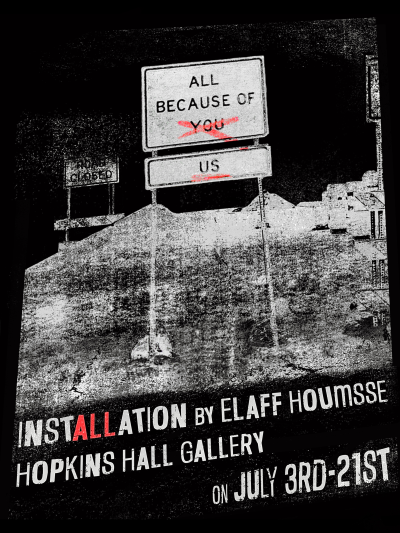Artist Interview with Elaff Houmsse: All Because of You, Us
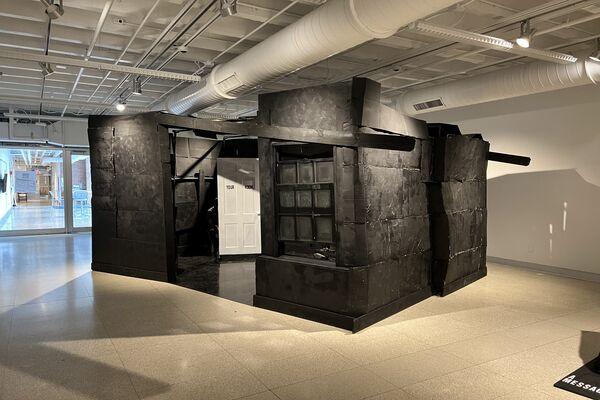
All Because of You, Us from Elaff Houmsse is on view at Hopkins Hall Gallery from July 3–21, 2023. A special community night—featuring live storytelling—will be held on Saturday, July 15 from 5–7 PM. Visitors can also join the artist for a closing event on July 21 from 5–6 PM at Hopkins.
In this exclusive interview, Urban Arts Space intern Toby Mars asks Houmsse to speak about the conceptual underpinnings of the exhibition.
1. What is your perception of the title All Because of You, Us in relation to your physical and digital installations?
The title All Because of You, Us represents our collective participation in a world where a lack of empathy towards one another is commonly practiced. The title is an after-the-fact statement, stating that this is how the world has become because we have been active participants. The installation is confrontational; viewers are to identify themselves within the work rather than remaining external spectators with no direct relation to them.
All Because of You, Us began through my introspection, holding myself accountable for being an active witness and participating in a disconnected culture. I found myself existing within a cycle. A cycle of hearing, reading, and even coming face to face with the travesties and hardships of others all while carrying on with my life as usual, whether it be headlines on the news, reposts on my phone, or even passing someone sitting on the street.
It is a privilege I—along with so many others—carry, where you can comfortably place yourself so far from someone else’s reality, in which you begin to ask: What does it take to get you to stop, to care? How has it gotten so bad? When did it become okay to be so actively dismissive? You may even ask yourself, was it ever any different? The selfish tendencies practiced within the current social climate are so embedded that every man is truly for himself. To the people who feel that I speak in hyperboles or that I am riddled in bold text, I ask you to think about the current state of the world. I ask you to extend an arm to the public and see what you get in return, to place yourself in the shoes of another, and when doing so, try not to let the shock of your circumstance be a signifier of the privilege you carry.
The physical installation had to represent a home/house to break the disconnect. A home is a place we all have a memory of, connection to, or even aspiration towards. A home is a place of significance, familiarity, shelter, family, etc. The relationship we all carry towards home is brought upon the viewer when entering the space. It could not be a foreign setting; the association of a home has strong signifiers for the viewer. In its physicality, All Because of You, Us is modeled after an abandoned and destroyed house. The state of the home is reflective of a circumstance as well as the impact that desensitization has placed upon the structure.
The digital platform www.allbecauseofus.com is an attempt towards change. Users can submit anonymous messages to the world, continuing to a shared space. It is a community, a place where people can come, and an effort towards listening. I wanted to create a space that actively practiced care and empathy. The title here is representative of the community. It is all because of us that this site functions, and all because of us that the platform is shared and the words of others are valued.
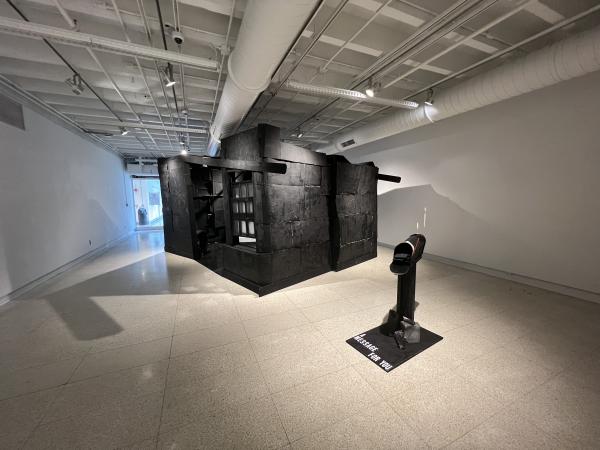
2. The sounds playing in the installation can be heard from down the hall of Hopkins. When inside the structure, they are impossible to ignore, even with the provided noise-canceling headphones. As the artist, how did you decide on the collage of noises and voices that play over the speakers? How does sound serve the overall energy of the environment and message?
The sound plays a significant role in this work; it is the soul of the installation. The soundtrack is a collection of real stories I have collected over time. I sought to find stories from people of all different backgrounds asking the world to respond, such as a protest on the streets, an interview with an individual, a news clip, etc. I wanted to overlap these voices so that you can still make out moments of these narratives independently as they play alongside one another but collectively become the voice of an “other.”
As you enter the gallery space, it is evident that the sounds are coming from inside the house. Upon entering the home, the sound is the loudest, and the viewers are directly thrown within the hardship of others, becoming a witness to the remanence of life around them. You can hear the words of others, the stories they tell, the sounds of destruction, etc. The installation is activated, and you can listen to them calling out to you. However, choosing to turn away towards “Your Room” is significant. It is the action of leaving, of neglecting to seek refuge in your room, your space, and a world that is not your own. In “Your Room” is where the noise-canceling headphones reside, and messaging/confrontation of that choice appears on the back of the door. The viewer is not only isolating themselves in their space but placing on the headphones to block out the tragedies of others. However, you can still faintly hear the sound even with the noise-canceling headphones. Just as you are aware that the world others live in continues to exist, you can still hear them to a degree and yet sit behind your door and read the messaging meant for you.
There is also an element regarding distance from the noise that plays a role in the work. As mentioned, you can hear the work; even as you are in the halls, you can hear echoes of the installation. There is a choice to come near the work or to continue walking to your destination, and if you are to follow the sound and enter the home, what happens next? There is beauty in realizing how you activate the space when everything is installed, and this was one of those moments.
3. What are your goals with the digital element of this show?
The digital platform (www.allbecauseofus.com) was created with the intention of giving users a platform to be listened to. Upon entering the website, you are prompted with “Send a Message, Gain a Message.” This is a space for people to share their thoughts, experiences, and ideologies; in essence, it is whatever people need it to be. All posts to the site are completely anonymous, giving users the freedom to express themselves without any associations or consequences.
Vulnerability and genuineness are two concepts I constantly find myself circling back to as a creative, whether within myself as a form of self-awareness or reflected upon as grounding elements within my practice. When intending to create the website, I wanted people to feel safe enough to share and be vulnerable. That being said, anonymizing the space gives users the liberty to do so.
I could not have been more moved by the responses I got on the site. Throughout this project, I could not have felt a greater sense of gratitude for people to trust me enough with their words and believe in this shared space. Even though I will never know who they are, I feel a closeness to this space and community.
4. The mailbox is a powerful image in the installation—to receive an anonymous message that represents someone else, somewhere else that you can’t reply to. How do you feel the physical letters in the mailbox interact with the digital messages on the website?
I knew that the messages of the website had to be represented within the physical installation solely based on their impact. I found myself consistently taken aback when reading and receiving messages online. It is the knowledge that someone out there in the world, in our world, is actively experiencing these emotions. That reaction to the letters is a key indicator of how disconnected we are, and it is very real and happening right now—to be so caught up in your own narrative that when you receive the lines from someone else’s story, there exists a part of you that is stunned.
I wanted to take the messages out of their digital presence and evoke that response with people who visited the installation. After being immersed within a setting where you are confronted with the unconscious or conscious practice of neglect, you leave with a message that someone left behind today. I hope that viewers hold on to the letters or celebrate the website as a symbol to strive for togetherness and care.
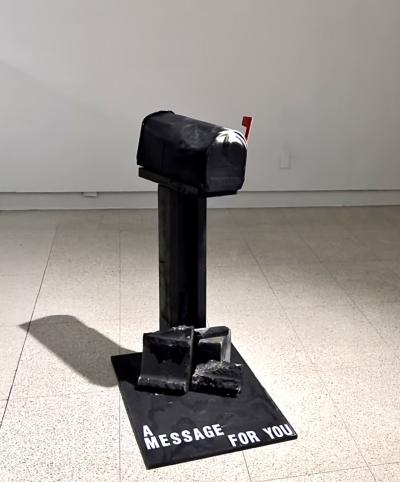
5. A core element of the show seems to be the acknowledgement of one’s complicity when it comes to the suffering and experiences of others. What does it mean to be complicit? What is one way people can create positive change?
To be complicit is to be silent or dismissive in the face of injustice. It is to allow normalized behaviors to excuse you from getting involved and obstruct any change—compliance to the notion that we are only responsible towards ourselves and not those around us.
We live in a society where division is systemically embedded and normalized into our cultural climate. One way to create positive change would be to become available to one another—to practice care in a world so isolated, first by recognizing its isolation and how we contribute. It is taking the time to identify what is pulling us apart and unlearning behaviors that have kept us divided. It can be as easy as listening to those around you without feeling as if it is a sacrifice of your time. It is spreading awareness and providing aid towards a situation as if it were your own. It is utilizing your privilege to represent those in a circumstance whose voices cannot be heard, regardless of how loud they plead.
We need to take accountability for our compliance and understand that we are the enabling forces that contribute to the current state of the world. Regardless of the systems we reside in or the dynamics in which we may unintentionally participate, you, as a human being, have a responsibility towards other people. It is not just your story—it is our story, for it is our shared world, and I believe that things can change with the awareness and willingness to do more. All because of you, all because of us.
6. What was the process of setting up this structure like for you? How do you emotionally respond to your piece?
The biggest behind-the-scenes factor of the installation was the fact that I did not have access to a large enough space to work on it continuously. The work measures to be around 10 feet in width, 15 feet in length, and 10 feet in height, and every time it was worked on, I had to reassemble it and take it down again. That being said, I worked on each phase of the installation independently, and it was not until I compiled them together within the gallery that I could see it in its entirety. When it all came together, I naturally did one thing—cry. I have been working on this project for six months, and if it wasn’t already obvious, I truly believe in this body of work. It has been the most rewarding experience for me from start to finish.
As a creative, I spend a lot of time with my work. I foster an idea and move with the utmost intention for even the smallest of details. I often joke and say I complicate things for myself; however, once the work is complete, you can’t help but be proud of how meticulous you have been. Standing in Hopkins Hall Gallery covered in black paint, I finally saw it all come to life and activate outside my mind. It was no longer a crazy idea I had gotten myself wrapped into; it was real and standing before me.
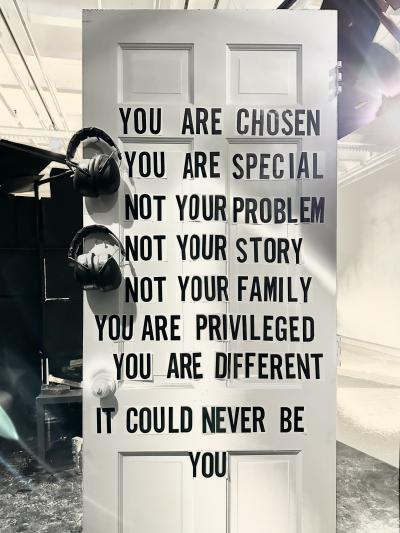
7. As a sculpture student, how do you feel this piece is different and/or similar to other works you have made?
All Because of You, Us is the first installation I have ever made, or as I like to frame it, “a sculpture you can walk into.” That being said, there is a lot of responsibility that comes into play when you are asking people to enter a work. Responsibility in terms of safety, structural integrity, as well as the impact that the environment could elicit upon a viewer. In this installation, I am asking viewers not only to enter but interact and, god forbid, “touch the art.”
In prior works, I have utilized abstracted and organic forms to represent the concepts I am exploring. However, All Because of You, Us heavily relies upon a representation that is familiar to the viewer. To remake a house representative of one, we are accustomed to drawing in the proper associations with the work to be understood. If I were to remake a home of a more organic build, the space becomes alien and perpetuates a greater disconnect. It was important to me to create a space that had recognizable qualities so that the fascination was less about the build and more about the message it exudes. I studied iconography heavily throughout this project, where you can utilize qualities and understandings of everyday objects and norms to your advantage—using symbols to draw out associations, such as the installation being remodeled after a house.
As a creative, I spend much time learning and studying the world around me. I create work from a place of introspection and discovery. All Because of You, Us is no different in that it aims to direct awareness to a greater problem in order to break down barriers.
8. What music do you listen to when you are brainstorming/working/making?
When creating, I find myself doing one of two things: hitting shuffle on my entire music library or working in complete silence. I am also a collector of many objects, and music is no different. My Shazam is always on, and I am always outsourcing music from the world as I stumble upon it. It's interesting to think about how much music can elicit a response or amplify a feeling, especially when one second you are playing Amy Winehouse and the next blasting Tyler, the Creator.
9. Who is one artist you love that you want more people to know about?
One artist I would love more people to know about is Nina Wells, who goes by the artist name 9A. She is a creative based out of Cleveland, Ohio, with a BFA in Photography from Columbus College of Art and Design. 9A utilizes a multimedia approach to create work that is centered around ideas of identity, spirituality, love, and the human experience. Often 9A places herself within the work to convey the overall subject matter of the work. She is limitless in her practice and approach to communicating with the world through many avenues.
9A was an artist featured in the Irrepressible Soul exhibition at Urban Arts Space in June 2023. Follow Nina Wells and Elaff Houmsse on Instagram to stay up to date on their latest exhibitions!
